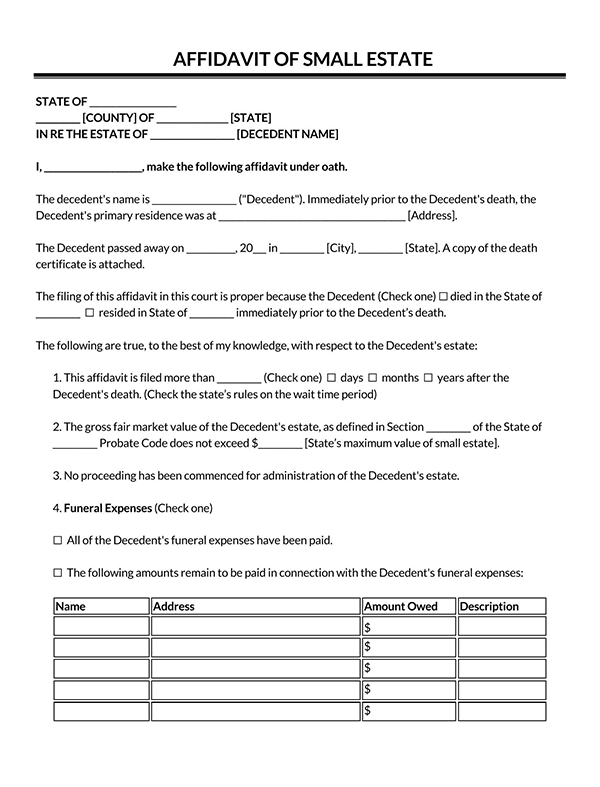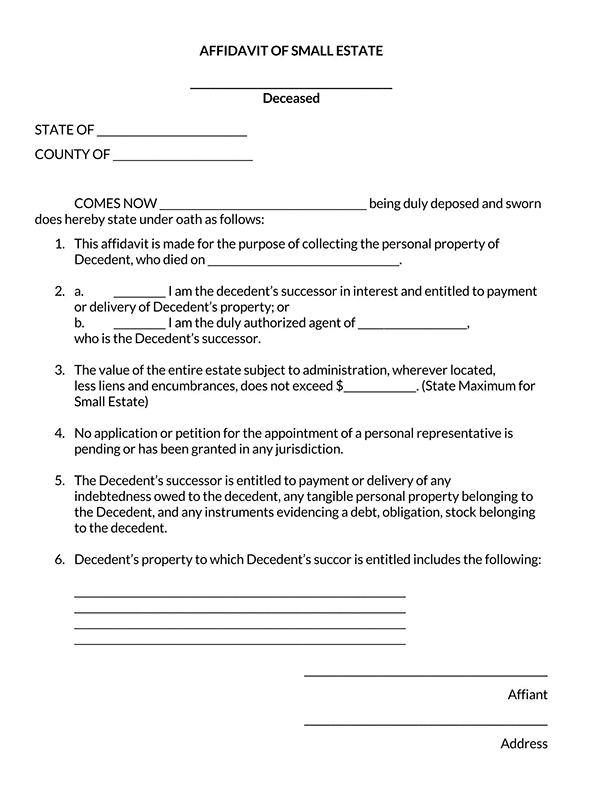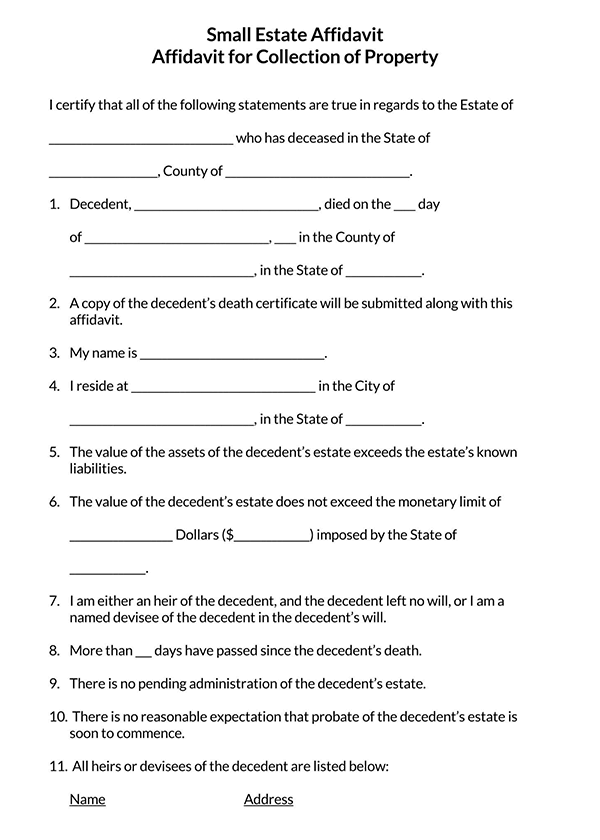A Small Estate Affidavit is a written statement that allows a rightful heir or relative to claim the property after the owner’s death.
A small estate affidavit is beneficial, especially if the owner did not create a will. An heir can skip the probate court process if this small estate affidavit is filed and hence claim the remaining property after the owner’s debt has been paid if any.
The term estate refers to all the personal assets and properties of the decedent that the heir or relative can claim. They should file a small estate affidavit with the party that is holding the estate, which might be the bank or a credit union. There is no need to use an attorney to file this small estate affidavit. However, an heir should always consult an attorney to have the correct information.
The estate’s value, the property type found in the estate, and whether or not the heirs (beneficiaries) are in agreement are usually considered when filing this affidavit. It is best for an heir to use the small estate affidavit to cut down on administrative expenses and reduce the time taken to benefit from the estate.
Alternate names for small estate affidavits include:
- Affidavit for collection of personal property
- Voluntary administration
- Affidavit in lieu of administration
Note: When it comes to a small estate affidavit, there are State requirements that should be observed by the heir or relative of the decedent. The small estate affidavit should be filed if the estate is worth a particular amount (in dollars) and after a certain number of days after the owner’s death.
For example:
Alabama accepts this affidavit only if the heir waits for 30 days after the owner’s death before filing it and the property in question is worth a maximum of $25,000.
There are different basic benefits of filing a small estate affidavit.
These benefits include:
- The heir will save their time and money by avoiding formal probate court proceedings.
- The heir can claim the property and access the assets faster than if probate court was involved.
Free Forms
Small estate affidavit forms – by type
Small estate affidavit forms – by state
Small Estate Affidavit vs. Probate process
The probate process is a formal court process where the judge decides who the heir and beneficiaries of the property will be after the owner’s death. This happens if there is no will or the small estate affidavit has not been filed.
This process usually takes a long time and can be very expensive. For the case of large estates, the probate process is essential to determine the estate and oversee its distribution. The court will be in charge of how the heirs are located, notified, and benefit from the estate. The court also ensures that all the property is accounted for and all debts are paid.
With a small estate affidavit, the heir can claim the property without lengthy probate court proceedings since the affidavit is a legal authorization.
Small Estate Affidavit vs. Affidavit of Heirship
A small estate affidavit is different from an affidavit of heirship. Although they are both filed by an heir who intends to claim the property of a decedent, the small estate affidavit usually highlights the owner’s estate, which includes their assets and debts. In contrast, the affidavit of heirship identifies all the heirs who are bound to inherit the decedent’s estate.
Most States usually have guidelines and laws that determine the heirs who can file a small estate affidavit. These deserving candidates include a spouse, a relative, or even a child of the decedent. In addition, the candidate who chooses to file a claim should get the signatures of all the other heirs who are also interested in the property or have equal rights to claim the property.
The Small Estate Affidavit Process
This step-by-step guide will offer clear instructions for using a small estate affidavit for an heir or relative of a decedent with no will in place.
These steps are:
Verify the value estimation of the small estate
Before filing the small estate affidavit, the first step is to determine if the decedent has an estate and what the estimated value of that estate is. Each state has a value limitation that the estimation value of the estate should fall under for the heir(s) to file an affidavit.
Also, only probate assets can qualify to fall under the estate. This includes all the decedent’s personal property, tangible assets, bank accounts, and brokerage accounts.
Property that does not fall under the estate known as non-probate assets includes jointly-owned assets, vehicles, real estate with transfer-on-death deed, or property and assets with rights of survivorship. Assets with beneficiary designations also fall under non-probate assets and may include life insurance policy and payable-on-death accounts.
Note: Each State has its own procedures for determining how real property can be distributed. That means that real property found in a primary residence may disqualify an estate form being considered small, and hence an heir cannot use this type of affidavit to file a claim.
Availability of the will
The next step after establishing the value of the estate is to confirm if there is a will. A small estate affidavit is only applicable if the will is not available. This rule depends on the state an heir lives in. There are other states that still allow for the filing of the small estate affidavit even if there is a last will and testament
In case there is a will, the heir should file it with the appropriate county clerk but not with the probate court, especially if they wish to use this affidavit. Taking control of the estate with an affidavit is usually done instead of going for the probate process. That means the affidavit cannot be used if another individual has started the probate process.
In case there is no will, the person with the affidavit must either be the decedent’s spouse or heir.
Wait for the state required time
For most situations, the lack of a will means that the heir should file a small estate affidavit if they wish to claim the decedent’s personal property. However, that means, depending on the state, the heir should wait for the required time to pass after the property owner’s death before filing the affidavit.
The time period is usually between 15 to 60 days. This period can be used to write down a list of the decedent’s assets and property. In case the heir is in a State without specific laws, they should reach out to the probate court once the decedent dies.
Collect necessary documents
After the required time has passed, the first step in filing a small estate affidavit is to collect all the required documents. This may include a copy of the death certificate of the property owner and the title of the property they owned, like a bank statement or a stock certificate.
Other documents include the original or copy of the will if it exists and the heir’s driver’s license or any other proof of identity.
Consult your attorney
The following process is to consult an attorney. Although they are not required when preparing and filing a small estate affidavit, an heir should choose to consult an attorney to get advice concerning any requirements they should observe regarding the affidavit. This way, an heir can correctly file the affidavit and avoid an expensive and time-consuming probate process.
Filing process
With advice from the attorney and the necessary documents at hand, the filing process can start, especially if the estate is within the required value and the minimum number of days has passed. The filing process is one step closer for the heir to claim the property and should be done correctly.
Fill out the form
The attorney can help the heir access the small estate affidavit form, or the heir can pick the form from the probate courts. With the form, the heir should fill out all the information requested. This may include the decedent’s information, the details of the petitioner, the heirs’ information, the State qualifications, and the signatures of the petitioner and two witnesses.
The best thing for an heir to do is to use the version of the form that is State-specific as it will increase the chances of it being accepted by the clerk’s office at the probate court. The heir should also fill out an itemized list of the assets and property owned by the decedent that will be distributed to the beneficiaries in the form.
The assets should be listed along with their value and details. The details may include a bank account number or motorcycle number. Other important basic information that should be included in the form is information about debts and funeral expenses.
Contact family members (heirs)
The heirs’ information will be accessed after the other heirs have been contacted. Apart from the heir, who is also the petitioner, there might also be other heirs interested in the property or have equal rights to claim the property. Therefore, the heir handling the petition should contact them through certified mail (with return receipt) to inform them about the small estate affidavit filing and access their signatures, saving the receipts as proof of notification.
Check notarization requirements by state laws
Some states like South Dakota and Rhode Island require that the small estate affidavit be notarized as part of the requirement. Therefore, an heir should confirm if their State Laws require that the small estate affidavit be notarized before filing.
File with the probate office
If all the steps have been observed, the heir has a valid affidavit and can file it with the probate office. They should attach all the required documents and have the filing fee to file the small estate affidavit successfully. The heir will have to wait for about five to fifteen days so as to know whether the affidavit was accepted or rejected.
Once the small estate affidavit has been accepted, the heir(s) can receive all the properties and assets.
Note: An heir can update the small estate affidavit form when they expire at a fee. The heir creating the affidavit (affiant) is the informal executor and distributes the assets correctly to the beneficiaries. They are also in charge of paying debts and any funeral expenses before distributing the properties.
What is Small Estate Affidavit Form?
A small estate affidavit template or form can be accessed from probate courts. This is what an heir(s) should fill out, sign, and then file to claim the decedent’s property if there is no will. Every state has its own small estate affidavit form that an heir can access.or
This can be done by downloading and using these provided affidavit forms that guarantee that the complete details and required information are present before signing and filing take place. With a proper form, an heir can avoid probate court and speed up the process of accessing the estate.
Final Words
A small estate affidavit is a written document that gives an heir the legal authorization to claim a decedent’s estate after their death, in case there is no will. The heirs may include the property owner’s spouse, relative, or child. The form can be accessed at the probate courts.
Each state has its own forms and requirements regarding filing this affidavit. However, it is important for an heir to prepare and file it to avoid the probate process. With a small estate affidavit, the heir(s) can avoid paying expensive attorney fees and spending a lot of time as the judge tries to decide who will inherit the decedent’s personal property.


